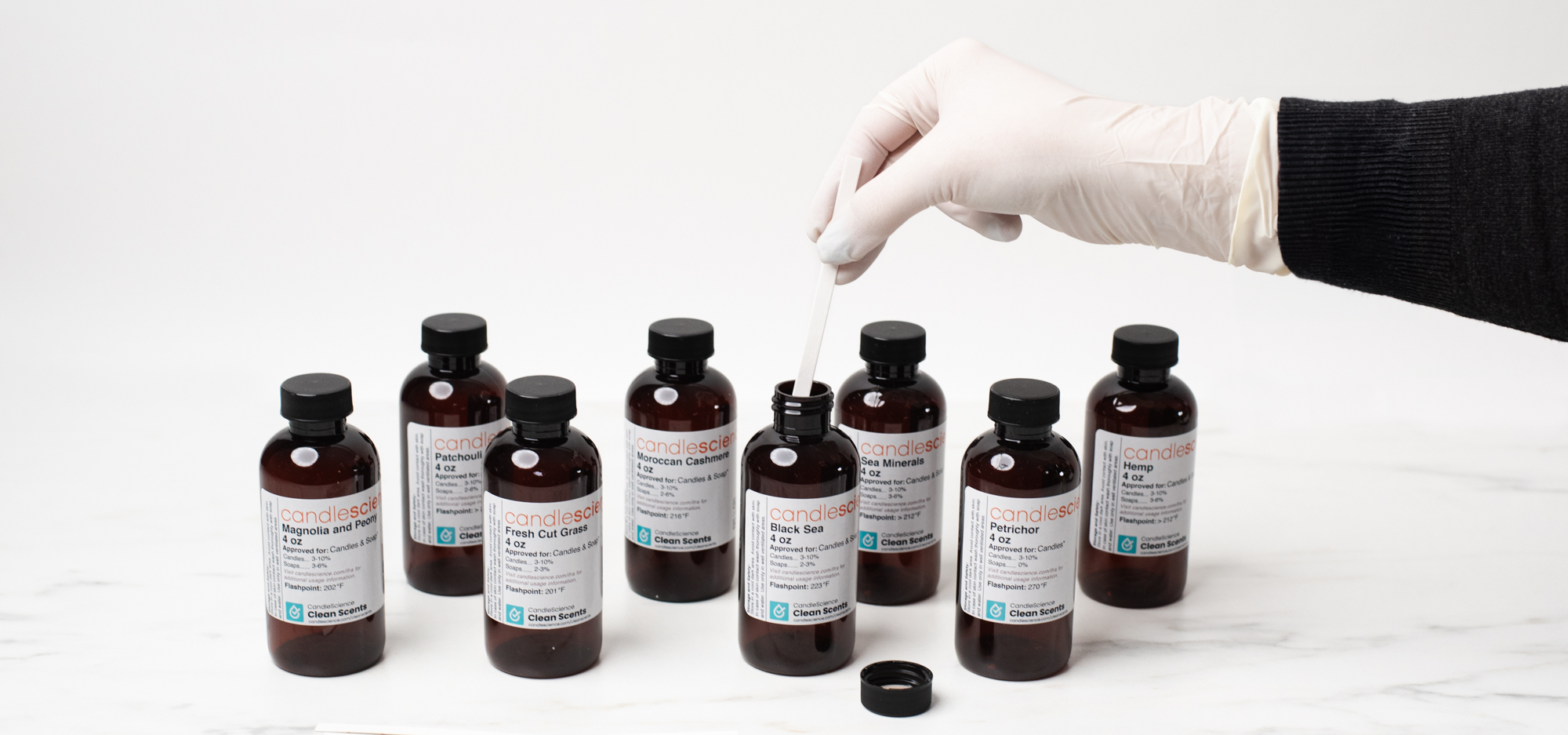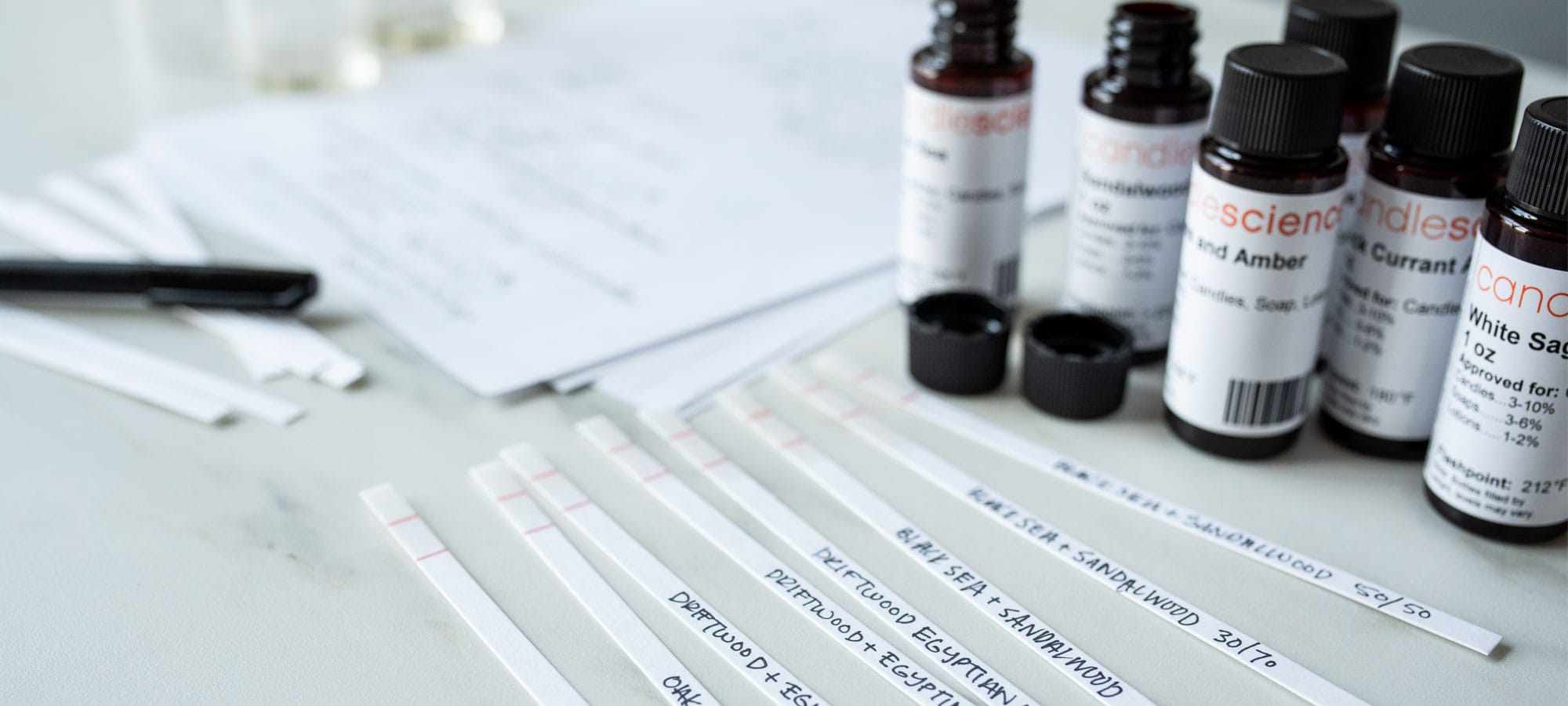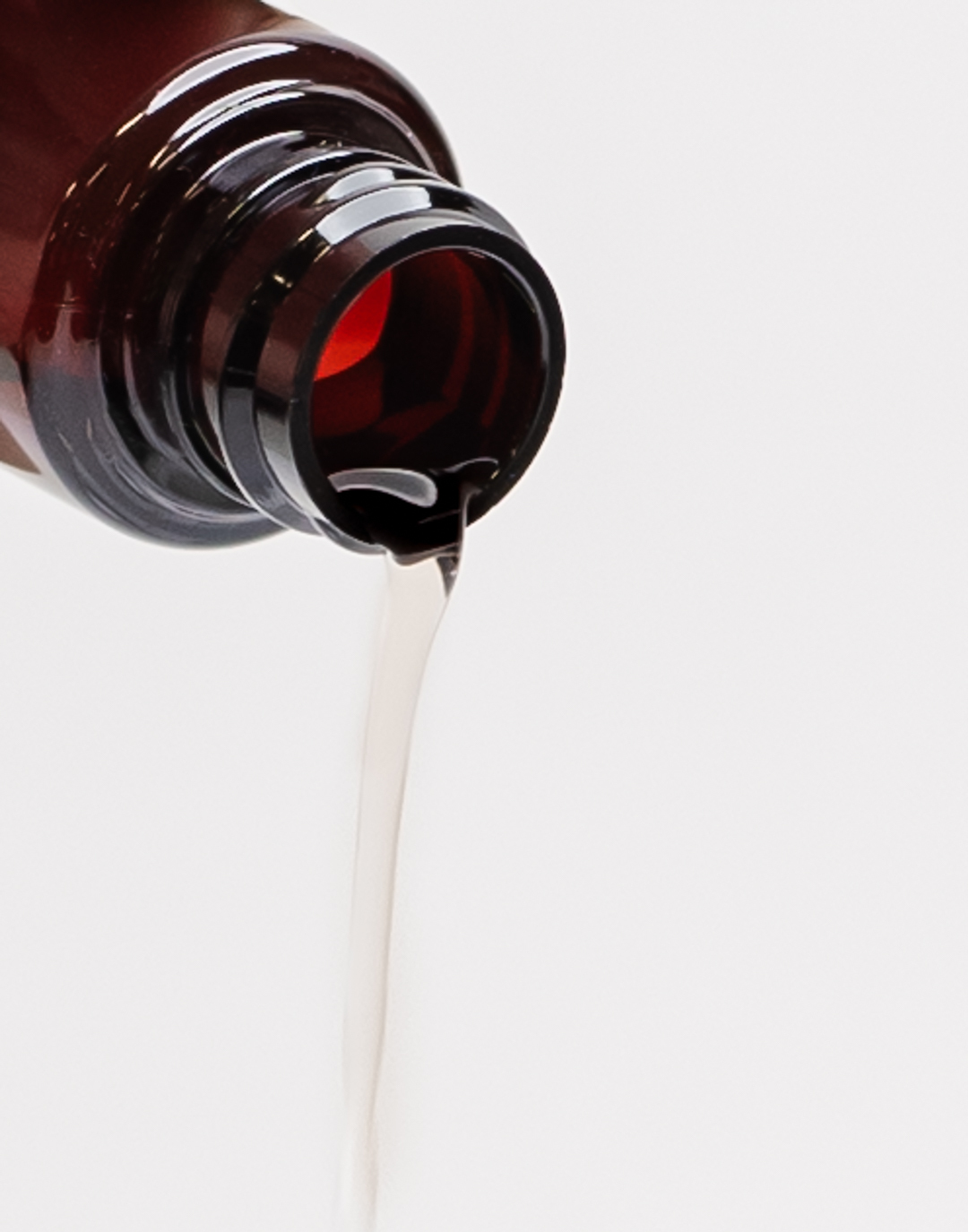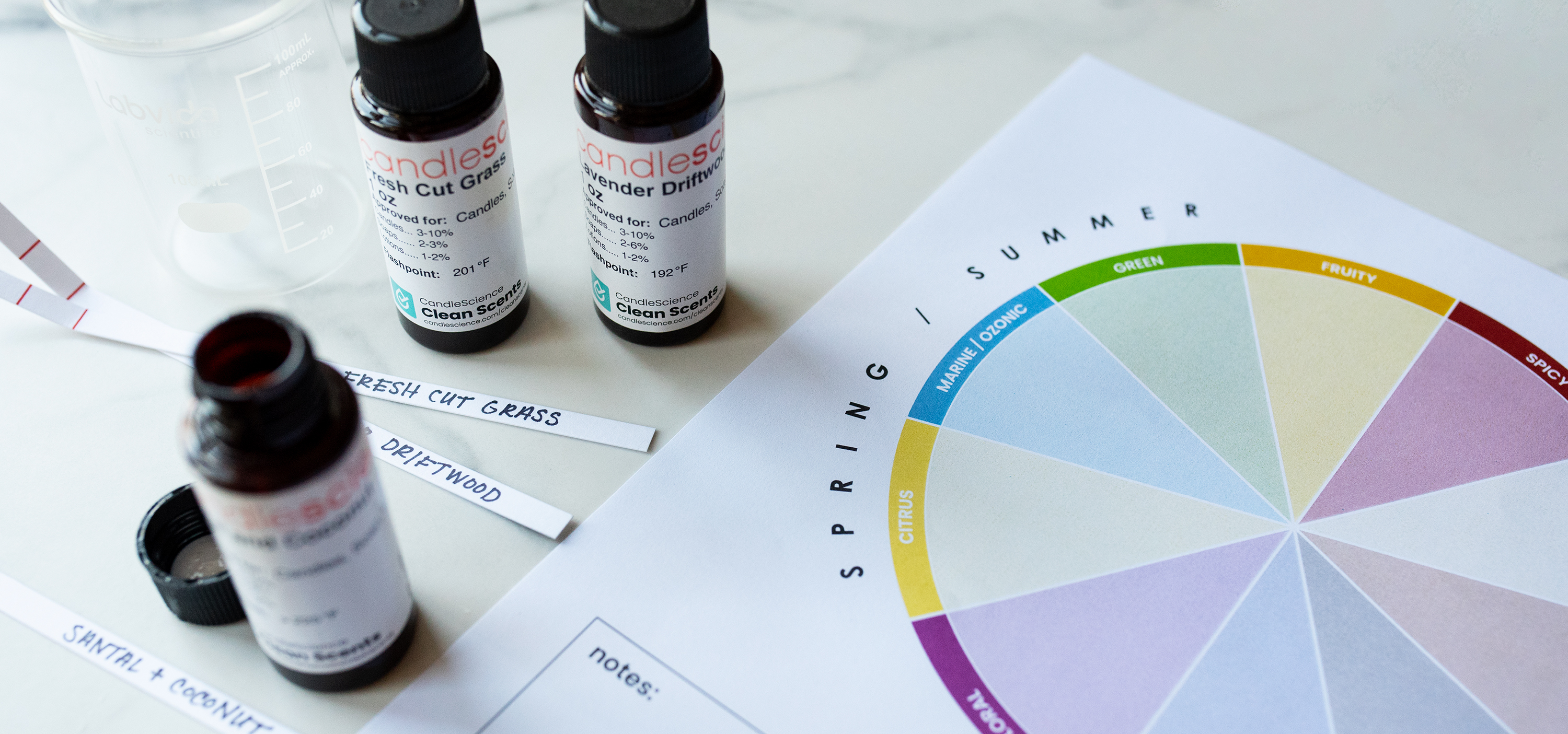How to evaluate fragrance oils

Evaluating fragrance oils is one of the most exciting steps of the candle making process! And while it may seem like a straightforward task, it requires more than a simple sniff test. In this guide, you’ll learn all the ways to evaluate fragrance oils so that you can get the most out of each and every one.
Fundamental fragrance terminology
Before we dive into fragrance oil evaluation techniques, let’s start by learning the meaning of common terms used when discussing fragrance oils.
Out of bottle (OOB): The term “out of bottle” refers to the way a fragrance oils smells straight from its bottle. If someone says they smelled a fragrance oil OOB, it means they uncapped the bottle and then held it a few inches away from their nose before smelling it. Often, OOB is used to represent “out of bottle smell” or “out of bottle impression.”
Cold throw: Cold throw describes the strength of fragrance before a candle has been burned for the first time. This evaluation is typically done within 24-48 hours of the candle being made.
Hot throw: Hot throw describes the strength of a fragrance while a candle is burning. This evaluation is typically done after burning the candle for at least two hours and forming a full melt pool.
Fragrance notes: We use notes to describe how fragrances smell. Just as musical notes come together to create melodies, fragrance notes are the building blocks for finished scents.
When we refer to “notes,” we’re talking about individual fragrance notes that make up a complete fragrance. When describing the overall scent of a fragrance oil, we use terms like aroma, scent, fragrance, character, and scent profile.
There are three types of fragrance notes, each playing a distinct role in the overall experience of a scent.
- Top notes: This is your initial impression of the fragrance oil when you first remove the lid of a fragrance oil bottle. Top notes are the most volatile, meaning they will evaporate the quickest. They’re also known as “head notes” or “opening notes.”
- Middle notes: The middle note, or “heart” of the fragrance, can take 10 to 20 minutes to fully develop. When you are burning a candle, the middle notes are the most prominent and steadfast throughout the burn cycle.
- Base notes: The base notes are what give a candle its lasting qualities. Also called the “dry down,” base notes linger even after the candle is extinguished.
Bookmark our Fragrance Note Glossary to discover the origins, nuances, and profiles of over 200 notes.
Want to learn all the common candle making terms? Check out our glossary of candle making terms.
Fragrance oil evaluation methods
Now that you’re familiar with the fragrance oil evaluation terms we'll use in this article, it’s time to go over various fragrance evaluation methods.
What should you look for when smelling fragrances?
Every maker has a different process, but it can be helpful to keep certain things in mind when evaluating new scents. Here are a few considerations as you hone your own fragrance oil evaluation method:
- Notice the emotional experience of the scent. How does it make you feel? Does it remind you of anything? Is it more familiar, or exotic? Two people can smell the same note profile and have completely different emotional experiences, but that’s one of the things that makes scent such an interesting artistic medium!
- Jot down a description of what you smell. Try to be as specific as possible, but don’t stress if you don’t have words for what you’re smelling at the moment—you can always come back and refine this later. If you smell something citrusy but can’t tell if it’s lemon or bergamot, then recording the word “citrusy” is perfectly fine, for example.
- Review the fragrance oil description and note profile from the supplier, then compare it with your notes. This practice helps train your nose to identify specific notes. It will also help you discern the note combinations you prefer, and those you aren’t a huge fan of.



OOB impression
- Smelling a fragrance oil for the first time is undoubtedly exciting, but it can often also lead to surprise—and potential confusion—if you smell the fragrance OOB.
- Top notes evaporate the quickest, so they tend to dominate the scent profile during OOB impressions. The overwhelm of top notes tends to mute middle and base notes, which can leave you with a skewed perception of the actual scent profile.
- OOB impressions are the easiest and fastest introduction to a fragrance, but they’re not necessarily indicators of the full experience a fragrance has to offer. While OOB impressions are a valuable and important part of the fragrance evaluation process, they should never be your only step in evaluating new fragrance oils.
Blotter strip evaluation
- You can probably guess why blotter strips are important now that you know more about OOB impressions! When you dip a blotter strip into a fragrance oil and allow it to air out, the fragrance oil components evaporate in a more gradual manner—this allows for a more balanced impression of the scent profile.
- You get a more accurate impression of fragrance oils on blotter strips because they give top, middle, and base notes time to bloom.
- Blotter strips provide a neutral medium for smelling and evaluating fragrance oils. To use blotter strips, dip the blotter strips into the bottle then let the blotter strips dry for about 10 seconds before smelling. Hold the blotter about an inch from your nose and smell to evaluate the fragrance oil. For more detailed instructions on using blotter strips to evaluate fragrance oils, check out our How to Use Fragrance Blotter Strips video. If you don’t have blotter strips on hand, cotton swabs are a good alternative in a pinch—just make sure they are made of paper and cotton because fragrance oils can degrade certain plastics.
- While blotter strip evaluations are a fast way to get a more complete picture of a fragrance oil’s scent profile, they can’t completely predict what a fragrance will smell like once it’s in a candle, soap, or other final product.
Cold and hot throw fragrance evaluations
- The cold throw evaluation is the best way to experience a fragrance as your customers would. Evaluating the cold throw of your candle mimics the shopping experience of smelling unlit candles.
- Hot throw evaluations are a preview of the candle burning experience. A scent’s character can change as the candle burns, giving you the full experience of top, middle, and base notes. Take notes on what you're smelling during different stages of the burn cycle.
- You’ll notice differences when comparing the cold and hot throw of a candle made with the same fragrance.
Cure time affects the strength and character of a scent, so evaluate the cold and hot throw of your candles after allowing them to cure fully. - Different waxes can yield different impressions of the same fragrance. Natural waxes like soy often have a more robust cold throw, while paraffin waxes are known for their intense hot throw. Always evaluate fragrance oils in the wax you intend to use them in.
Evaluating fragrance oils in soap
- The scent and character of a fragrance oil blooms and develops nuances during different stages of the soap making process. You may not be able to detect any differences between a fragrance’s blotter strip impression and the way it smells in a freshly made bar of soap, only to be surprised by the way it smells after curing. Allow soap to fully cure before assessing fragrance strength and character. You only need to wait one day for melt and pour soap to cure.
- With cold process soap making, the character and strength of a fragrance oil can change more dramatically. Cold process soap can be a harsh environment for fragrance oils—there are many variables that can affect the performance of fragrance oils, and it’s generally recommended to cure cold process soap for at least four weeks. However, most fragrance oil suppliers test their soap-safe fragrances in cold process soap to give makers a preview of what they can expect. To learn more about our method for testing fragrance oils in cold process soap, take a look at our Cold Process Soap Fragrance Testing notes.
- Note any differences in the smell of your soap before and after lathering up. Water combines with soap as you lather, then releases scent compounds throughout the air when it vaporizes. To fully understand the character of a fragrance oil in soap, evaluate it during both dry and lathered phases.
Fragrance oil evaluation FAQs
Many of the tips that increase hot throw strength also improve the overall performance of your candles. We can often be our harshest critics, so be mindful that mastering anything is often a learning experience. Every candle you make—strong hot throw or not—is a step in the right direction.
Does scent change with different fragrance loads?
The fragrance load can absolutely affect our perception of scent. Some fragrance oils smell more balanced when used at lower fragrance loads, while others seem to maintain the same character at different levels.
Because it’s hard to predict how fragrances smell at different fragrance loads, testing is the best way to determine the optimal fragrance load for your individual preferences.
What if I can’t smell anything at all?
Nose blindness, or olfactory fatigue, is a real phenomenon! The longer we’re exposed to the same scent, the more our body tunes it out. When visiting a friend’s home, you’ll pick up on odors they’ve become accustomed to and can no longer perceive. Our body does this to prevent us from becoming overwhelmed by the various scents in our environment—if we could always smell every aroma surrounding us, it would be difficult to think about much else!
If you’re having trouble smelling a scent that you’re already familiar with, olfactory fatigue could be the cause. Reset your senses by taking a few minutes away from the fragrance and smelling the neutral aroma of your own skin. We often smell the inside of our arms or the “elbow pit” to give our noses a reset when we evaluate fragrance oils.
And resist the urge to use coffee beans for this purpose! Remember those department store perfume counters lined with canisters of coffee beans? There’s actually no scientific backing to support the notion that they help reset your senses. The coffee bean perfume counter myth was so pervasive that researchers from Beloit College published a study on it. So while coffee beans don’t seem to negatively affect olfactory fatigue, they also won’t help. We recommend skipping them.
If you're still unable to perceive the scent of a fragrance oil after taking some time to reset, it might be a good idea to take a COVID test. We all know that loss of smell and taste are common symptoms of COVID, but they can present before other cold-like symptoms—sometimes leading people to ignore COVID as a potential cause. However, negative fragrance and perfume reviews were observed as a statistically significant indicator of COVID surges.
Do environmental factors affect the smell of fragrance oils?
Yes! We perceive scents when they’re carried through the air and to our olfactory receptors. Humidity is one of the largest environmental factors when it comes to our sense of smell. Researchers speculate that an increase in humidity correlates to an increase in olfactory detection of odorants—in layman's terms, more humid conditions make it easier to perceive scents!
The way air circulates throughout an area is important, too. If you’ve ever burned candles in rooms with high ceilings, you probably noticed that it took longer than usual to get much of a hot throw. Keep room size in mind when evaluating fragrances; you may realize that candles you thought were too weak were simply burning in a room too large for them.
Now, start nosing around!
You shouldn’t judge a book by its cover, and now you know why the same is true for fragrance oils! With time, you’ll develop your own unique process for evaluating fragrance oils.
The most important part of fragrance evaluation is to have fun with it! Learning the nuances of fragrance will happen with experience, so just focus on figuring out which fragrances resonate with you or align with your brand when starting out. Record your thoughts as you evaluate each fragrance, then see if you can find any similarities in the scents you love the most.
Additional fragrance oil evaluation resources
Ready to really have some fun with fragrance? Check out these resources for a crash course in fragrance for candle and soap makers.

Fragrance Oil Blending 101
With a bit of know-how and a little creativity, anyone can become a fragrance mixologist!

How To Select Fragrance Oils for Luxury Candles
Learn how to select fragrance oils for luxury candle collections.

The Fragrance Wheel: Notes, Families, and How To Use It
Understand the relationship between different olfactory categories.
Do you have any lingering fragrance oil evaluation questions? Drop your comments below!